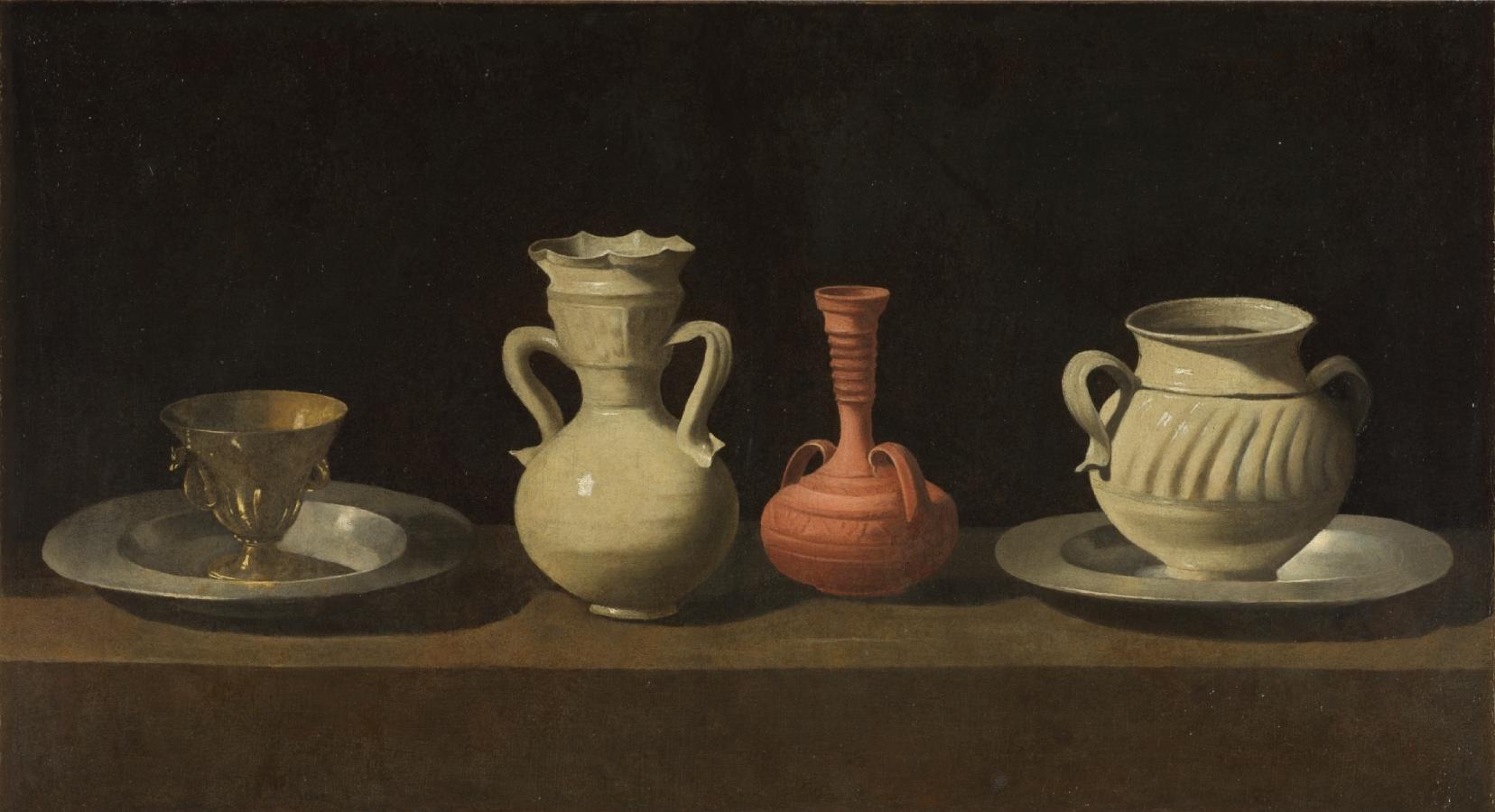Zurbarán, Francisco de (1598-1664)
Bodegón con cacharros (Still-Life with Pottery Jars)
c.1650
Oil on canvas, 46 x 84 cm
Museo del Prado, Madrid
Various vessels of different materials, shapes and uses rest on a wooden surface that could be a table or a shelf. From left to right they are: a pewter plate holding a complex and refined goblet, probably of gilded silver; a water jug from Triana of the short known as eggshell (made of porous earthenware that cools water though evaporation), a vase from the Indies (probably from the Viceroyalty of New Spain, perhaps Tonalá), and finally, another white jug from Triana resting on another pewter plate. One of the fundamental protagonists of this work is light, which brings the objects out of the shadows and heightens their colors and volumes. Still, the most important one may be the sense of silence, which is almost palpable. And finally, the artist’s mastery in producing a timeless work, as well as the objects themselves, which are configured in a painting that has inspired critics, scholars and poets. This painting is one of the still lifes most frequently considered prototypical of Spain’s Siglo de Oro, and often used by art historians in their considerations of Zurbarán’s compositional wisdom, his taste for the essential and his tendency, on occasions, toward geometric rigor. And yet, it is also an authentic exception in the history of Spanish still lifes. It has numerous aspects that contradict the rules of perspective and geometry, although this often occurs in works by Zurbarán, who never stood out for his mastery at representing even slightly complex spaces in his paintings. What makes this work so distinct from others of its genre in Spain is its absence of time, which is precisely one of the elements used to unify the contents of other works of this type. Time is frequently specified in these works by the presence of flowers or foodstuffs, and when objects related to nature do not appear, there is often a skull to announce the ineluctable destiny of humans, and by extension, of all things. At other times, a clock appears as reminder that all things change for everyone, and that nothing in this world is immutable. In the present still life, the only reference to time is the light, with its shadows, which is, of course, essential. This work’s stature as an archetype of the Spanish still life is undoubtedly due to its high quality, its exhibition in an institution known throughout the world, and a historiographic tradition that identifies Spanish still lifes with stripped-down rhetoric and a search for essence (in contrast with the opulence and sensuality of Italian and Flemish still lifes, the sumptuous contents of Dutch ones, and the decorative character of French ones) while ignoring the relative variety of formulas and tendencies that characterize this genre on the Iberian Peninsula. In his unhurried approach to this work, Zurbarán must have painted each element in a calculated manner -one by one, and in order. That explains why certain objects project no shadow and others transmit such a powerful individual presence. In their placement, we can see that they are not really aligned, but instead, slightly off their natural axis. This is no coincidence; it has been done to favor the play of light and to create the volumes in a more believable and powerful way. We should also note that the objects in this still life are not strictly popular vessels. They could well belong to the tableware of a household of certain wealth -especially the gilded silver goblet and the vase from the Indies. A very nearly identical version of this work, although in somewhat better condition, was donated to the Museu d’Art de Catalunya by Cambó, the same collector who donated the present work to the Museo del Prado in 1940. (Luna, Juan J., El bodegón español en el Prado: de Van der Hamen a Goya, Madrid, Museo Nacional del Prado, 2008, p.82-83)
